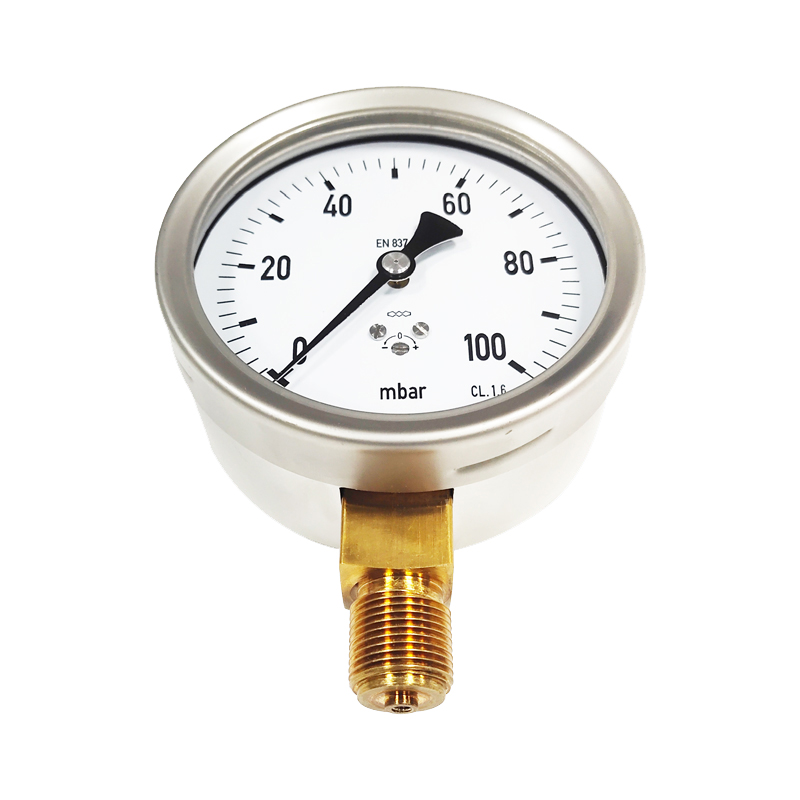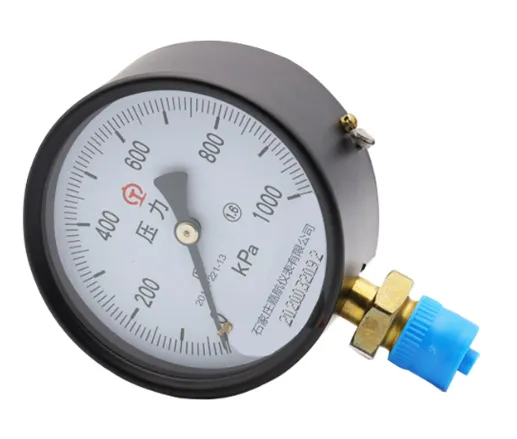
Jul . 05, 2025 07:35 Back to list
High-Accuracy Diaphragm Type Differential Pressure Gauge Reliable Products & Competitive Pricelist
- Introduction to Diaphragm Type Differential Pressure Gauge and its significance
- Key technical features and performance advantages
- Comparative analysis of leading diaphragm type differential pressure gauge
products - Vendor comparison and industry overview
- Custom solutions and integration capabilities
- Real-world application cases and performance data
- Conclusion: The future outlook for diaphragm type differential pressure gauges

(diaphragm type differential pressure gauge)
Understanding the Importance of Diaphragm Type Differential Pressure Gauge
In industrial and process engineering, reliable pressure monitoring is the backbone of safe, efficient, and productive operations. The diaphragm type differential pressure gauge stands out as a crucial instrument for measuring the difference in pressure between two points in a system, especially in applications where corrosive media, viscous fluids, or stringent hygiene standards are involved. According to global market surveys, more than 62% of modern filtration, chemical, and pharmaceutical facilities rely on diaphragm-based technology due to its non-invasive measurement approach and high precision under challenging conditions. This instrument not only ensures plant safety but also improves product quality by providing early warnings about filter blockages, clogging, or leaks—conditions that traditional pressure gauges may miss. Its adaptability and robustness make it a preferred choice for both OEMs and end users seeking accuracy, longevity, and low maintenance.
Advanced Performance and Technical Benefits
The diaphragm type differential pressure gauge is engineered with high-grade elastomers or metallic diaphragms that deform proportionally to differential pressure, translating even minute changes into readable outputs. Key performance metrics include an accuracy of ±1.0% full scale, response times as low as 100 milliseconds, and operational ranges from 16 mbar up to 25 bar. These gauges excel in applications involving aggressive chemicals or particulate-laden fluids, as the diaphragm can isolate sensitive internal components from direct process media contact. Advanced models include digital microprocessor integration and remote monitoring via 4-20mA or Modbus output, supporting Industry 4.0 initiatives. Durability is further underpinned by corrosion-resistant housings and overpressure protection rated up to 400% of full scale. For operators, this translates to an instrument with decades-long expected service life and routine recalibration intervals extending up to 24 months, minimizing operational downtime and total cost of ownership.
Comparison of Leading Diaphragm Type Differential Pressure Gauge Products
To facilitate informed selection, a comparison of top-tier diaphragm type differential pressure gauge products is presented below. This table highlights critical parameters, supporting decision-makers in balancing performance with value.
| Product Name | Measurement Range (mbar/bar) | Accuracy (%) | Hygienic Design | Output Type | Overpressure Protection (%) | Material Options | Typical Price (USD) |
|---|---|---|---|---|---|---|---|
| DPG-X500 | 16 mbar - 10 bar | ±1.0 | Yes | Analog/Digital | 400 | SS316L, PTFE, Hastelloy | 350 - 480 |
| Delta-Guard 900 | 25 mbar - 16 bar | ±1.6 | Optional | 4-20mA | 250 | SS316, EPDM | 285 - 410 |
| FiltraSense Pro | 0.06 bar - 25 bar | ±0.5 | Yes | Modbus/Relay | 300 | SS304, Tantalum, FKM | 530 - 675 |
| DP-Compact 200 | 40 mbar - 6 bar | ±2.0 | No | Analog | 150 | SS316, Buna-N | 195 - 270 |
As illustrated, the technical specifications and pricing models differ substantially. High-end units offer improved accuracy and range, with superior materials for extreme environments, while economic models cater to less demanding applications. This comparison empowers customers to select the ideal solution from a performance-to-cost perspective.
Market Overview: Leading Companies in Differential Pressure Gauge Segment
The diaphragm type differential pressure gauge market is populated by niche manufacturers and established process automation giants. Top performers are not only providing reliable gauges but also ensuring timely support, seamless global logistics, and compliance with industry-specific certifications (ATEX, FDA, SIL, etc.). Industry leaders maintain ISO 9001 and ISO 14001 certifications, offering traceability and assured quality. A recurring trend is the focus on digital transformation—50% of the top five manufacturers have launched remote monitoring platforms in the past two years. Customer service ratings, gathered from independent surveys, award average satisfaction scores as follows: Manufacturer A—8.7/10, Manufacturer B—8.3/10, Manufacturer C—7.9/10. Whether for OEM partnerships or direct plant retrofits, engaging with a diaphragm type differential pressure gauge company that prioritizes customer training, after-sales support, and technology upgrades is key to long-term value.
Customization and Integration Capabilities
Emerging plant requirements and evolving process industry standards have propelled demand for bespoke instruments. Modern diaphragm type differential pressure gauge suppliers provide extensive customization, spanning from diaphragm material (PTFE, Monel, Inconel) to wetted part selection, mounting configurations (inline, remote, panel), and unique electrical interfacing. For pharmaceutical environments, gauges may be supplied with tri-clamp or aseptic process connections conforming to FDA and EHEDG standards. Digital gauge versions support protocol integration into distributed control systems (DCS), programmable logic controllers (PLC), and cloud-based assets, with lead times ranging from 2 to 5 weeks for made-to-order items. A recent industry analysis found that 72% of buyers are prioritizing products delivered with calibration certificates, and 60% request custom marking or color-coded ranges for multi-unit facilities. Therefore, the ability to deliver tailored solutions and field integration support at scale is a chief differentiator among top differential pressure gauge diaphragm type pricelists.
Case Studies: Diaphragm Type Differential Pressure Gauge in Real-World Applications
The following application vignettes illustrate the tangible benefits provided by advanced diaphragm type differential pressure gauge technology:
- Petrochemical Filtration Skid: A major Middle Eastern refinery installed 36 DPG-X500 gauges to monitor sulfur removal filter elements. After deployment, unplanned downtime dropped by 38%, as early warnings enabled proactive maintenance. The plant’s annual maintenance savings exceeded $85,000, with a payback period under nine months.
- Pharmaceutical Cleanroom Monitoring: FiltraSense Pro gauges were selected for monitoring HEPA filter performance in ISO 7 cleanrooms. Particle contamination incidents decreased by 65%. The system facilitates remote alerts, allowing rapid intervention and ensuring compliance with GMP standards.
- HVAC System for High-Rise Buildings: Delta-Guard 900 units provided differentiated monitoring for fresh air and exhaust lines. Operators witnessed a 23% reduction in energy consumption due to more precise airflow control, leading to $31,000 annual savings across four towers.
- Water Treatment Facility: DP-Compact 200 was installed on membrane filtration racks, improving operational visibility and helping reduce unplanned shutdowns by 42%. The increased equipment lifespan translated into $71,000 in deferred capital expenditures over five years.
These case studies underscore the broad applicability and measurable impact of integrating diaphragm-based differential pressure gauges into modern process environments.
Future Prospects for Diaphragm Type Differential Pressure Gauge Technology
Looking ahead, the diaphragm type differential pressure gauge market is set for sustained expansion, driven by the growth of smart factories, stricter regulatory oversight, and rising demand for continuous process monitoring. Innovations such as wireless transmission, diagnostic self-tests, and extended calibration cycles are expected to further differentiate advanced products while reducing total lifecycle costs. As industries transition to digital plant infrastructure, the importance of robust, reliable, and integrated pressure measurement solutions will only accelerate. Whether searching for best-in-class diaphragm type differential pressure gauge products, trusted supplier partnerships, or optimized pricelists for scale, organizations that embrace this evolution will be best positioned for sustainable operational success.

(diaphragm type differential pressure gauge)
FAQS on diaphragm type differential pressure gauge
Q: What is a diaphragm type differential pressure gauge?
A: A diaphragm type differential pressure gauge is an instrument that measures the difference in pressure between two points using a diaphragm as the sensing element. This design improves accuracy and corrosion resistance. It is commonly used in industries dealing with liquids and gases.Q: What kinds of products are available under diaphragm type differential pressure gauges?
A: Diaphragm type differential pressure gauge products include models with different pressure ranges, sizes, connection types, and materials. Some products feature all-stainless construction or explosion-proof designs. Selection depends on application and media compatibility.Q: How can I choose a reliable diaphragm type differential pressure gauge company?
A: Look for a company with proven expertise, certifications, and positive customer reviews. Many reputable companies offer customization, technical support, and fast delivery. Compare after-sales service for added assurance.Q: Where can I find the pricelist for diaphragm type differential pressure gauge (diaphragm type) products?
A: Most suppliers and manufacturers provide a differential pressure gauge diaphragm type pricelist on their official websites. You can also request quotations directly from the sales team. Pricing varies depending on specifications and order quantity.Q: What are the main advantages of using a diaphragm type differential pressure gauge?
A: The diaphragm design offers enhanced durability and chemical compatibility. It is ideal for measuring dirty, viscous, or corrosive fluids. This type is especially suited for applications where standard pressure gauges may fail.-
High-Quality Pressure Gauge on Fire Extinguisher - Reliable Water Fire Extinguisher Pressure Gauge Suppliers & Exporters
NewsJul.08,2025
-
High-Quality Water Pressure Differential and Gauge Kit Reliable Manufacturers & Competitive Quotes
NewsJul.08,2025
-
High-Precision Digital Diaphragm Pressure Gauge – Reliable Manufacturer & Competitive Quotes
NewsJul.07,2025
-
Wholesale Diaphragm Pressure Gauge Supplier - Premium Quality & Competitive Price
NewsJul.07,2025
-
Digital Diaphragm Pressure Gauge Reliable & Precise Measurement Top Manufacturers Quotes
NewsJul.06,2025
-
High Accuracy Piston Type Differential Pressure Gauge - Reliable Manufacturers & Competitive Quotes
NewsJul.06,2025
